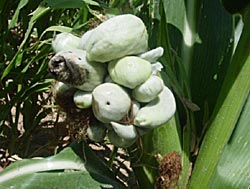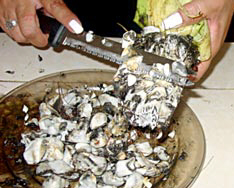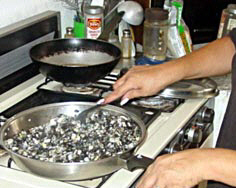|
Huitlacoche, sometimes called corn mushroom, corn smut and Mexican truffle, is a fungus of the mushroom family that grows on corn that has not been sprayed with a fungicide. It is available fresh or canned. While fresh huitlacoche is common in México in the corn season, it is rarely found in the USA except in cans in Mexican markets. (Cuitlacoche is the anglicized spelling that is sometimes used in México as well.) Today Adriana is making two dishes -- huitlacoche de Mexicana and tlacollos. Huitlacoche de Mexicana is a base that is often used in tamales, tacos, quesadillas and a variety of other dishes. It also is an excellent side dish alone or with a sprinkle of grated cheese. Tlacollos are more common in southern México. It is similar to a gordita. Nery and I went far out into the farming area west of Lerdo to find the fresh huitlacoche. We followed a maze of dirt roads across the desert following the irrigation cannels to the corn fields. I asked Nery if he was sure he knew where we were going (and the way home). He said the farm were he grew up was near by and that as a boy he had ridden his horse over all of the area. I smiled, remembering my own boyhood exploring on my horse in the ranching country of Central Texas. We passed several fields before we found one that was "infected." The farmer gave us permission to pick as much as we wanted. The farmer knew Nery because they are both members of Ejido Lerdo. Nearby fields were being harvested by a machine that cuts the stalks near the ground, shreds the whole plant, and dumps it into an accompanying truck for transport to a silo at a dairy farm. The dairy operator contracts with the corn farmer to grow the corn to be turned into silage. The dairy furnishes the seed, fertilizer and the harvesting, and then pays five pesos per kilo of the harvest (about US$0.22 per pound) -- pure profit to the farmer. Other areas grow corn for human consumption. |
||
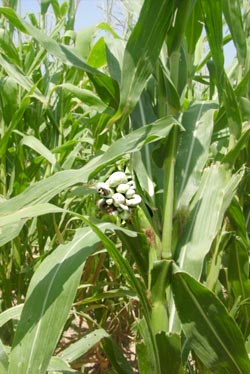 |
As the fungus grows, it pushes out of the shucks around the corn and becomes clearly visible in the field. Not all the corn in the field will be affected. It took Nery about half an hour walking through this field to find a dozen ears with huitlacoche. The picture below is a close up of the corn on the left. |
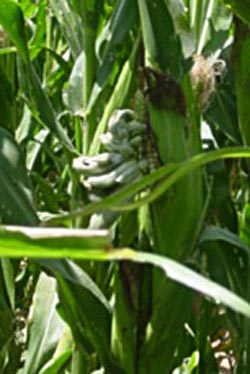 |
|
|
||
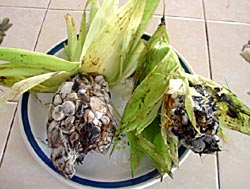 |
|
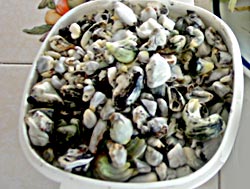 |
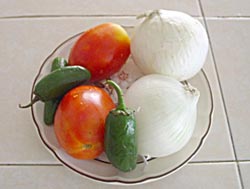 |
The fungus completely consumes the corn kernels. When Adriana cuts it off, only the bare cob is left. Lets face it -- the stuff looks yucky, but it tastes just fine raw or cooked. The huitlacoches will be slowly sautéed in olive oil with two finely diced onions and two chopped tomatoes, with chiles to taste. |
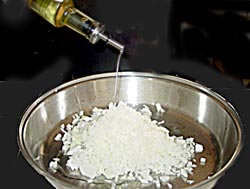 |
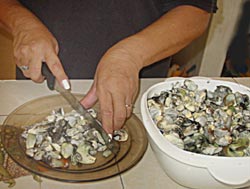 |
|
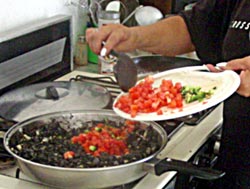 |
|
While the onions are cooking, she dices the huitlacoches and then adds them to the onions which have cooked over low heat for 3 or 4 minutes. As the huitlacoches cook, they turn black. |
When the huitlacoches have completely blackened, she adds the chopped tomatoes and chile. |
|
|
While the mixture continues slow cooking for another 20 minutes or until most of the liquid has evaporated, Adriana begins the tlacollos by preparing a masa dough as we watched her do in the sopes story. She forms a patty of dough and presses a groove down the center which she fills with the cooked huitlacoche. |
||
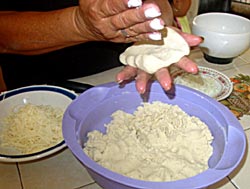 |
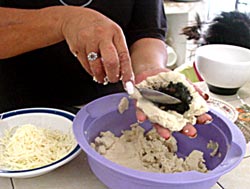 |
|
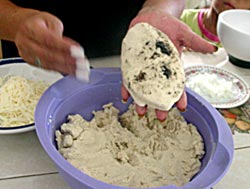 |
She adds a top of dough and then pats the tlacollo into a large leaf shape. It is fried in vegetable oil until golden brown. This is really just a gordita that was stuffed before frying instead of after. |
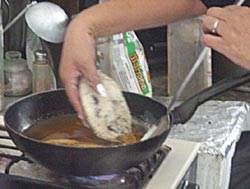 |
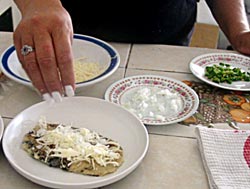 |
Each tlacollo is topped with grated cheese, onions and chiles to taste. In the excessively large serving she made for me, she included the huitlacoche de Mexicana as a side dish, which I liked very much. I ate some of it in a soft tortilla wrap with some cheese and diced onion -- excellent. |
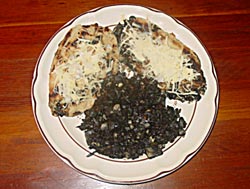 |
|
Huitlacoches can be used raw in a salad or any other place were a common mushroom might be used. For eating raw, select the ones that are still all white. As they turn black on the plant, the texture changes. The black and dirty looking ones are fine for cooking, but the clean white ones are better for eating raw. Leftover huitlacoche de Mexicana can be frozen. |
||
| If you wish to write to Adriana Rosales you may send an e-mail to AdrianaR@rollybrook.com | ||
| Cooking Directory | ||
